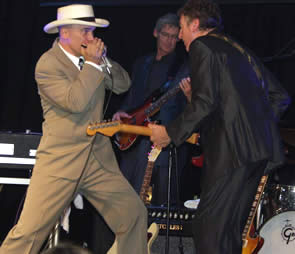Making It In 4th Position – When Johnny Comes Marching Home […with tab]
And let each one perform some part, To fill with joy the warrior’s heart.. Louis Lambert
Applying the circle of 5ths to a C Major diatonic harmonica enables us to determine the alternative keys and their associated positions that are available on the same harp. As a reminder:
1st position (straight harp) is in C major. Your root note is generally blow 4.
2nd position (cross harp) is in G major. Your root note is generally draw 2.
3rd position (slant harp) is in D minor. Your root note is generally draw 4.
4th position is in A minor. Your root note is generally draw 6.
 The first three are the most widely used positions on the harmonica. In each case it is helpful if we can find a well known melody that best demonstrates that position and will map out the principle safe notes for us. In first position the choice is limitless. The most often used melodies are Camptown Races, Oh Susannah, When The Saints Come Marching In and Amazing Grace. In second position the choice is also very wide, especially when we start to use bent notes. In third position the melody to Scarborough Fair is the best example I have come across. You can also try What Shall We Do With A Drunken Sailor or even the theme to the Hawaii 5-O TV series. For mapping out fourth position, try When Johnny Comes Marching Home.
The first three are the most widely used positions on the harmonica. In each case it is helpful if we can find a well known melody that best demonstrates that position and will map out the principle safe notes for us. In first position the choice is limitless. The most often used melodies are Camptown Races, Oh Susannah, When The Saints Come Marching In and Amazing Grace. In second position the choice is also very wide, especially when we start to use bent notes. In third position the melody to Scarborough Fair is the best example I have come across. You can also try What Shall We Do With A Drunken Sailor or even the theme to the Hawaii 5-O TV series. For mapping out fourth position, try When Johnny Comes Marching Home.
Here’s the tab:
5B 5B 6D 6D 6D 7D 7B 7D 7B
6D 6B 5B 6B
5B 5B 6D 6D 6D 7D 7B 7D 7B
8D 8B 7B 8B
7B 8D 8B 8B 8B 8D 7B 8D 8D 8D
7D 7B 7B 7B 7D 6D 7D 7D 7D
7B 8D 8B 8D 7B 7D 5B 5B 6D 6D 6D 6B 6D
For the bluesers amongst you, the A minor blues scale can be found here:
Upper octave 6D 7B 8D 8B’ 8B 9B 10D
Lower octave 3D” 4B 4D (Overblow 4) 5B 6B 6D
Good harping to you!

There is very little information re fourth position on the web. This is a fantastic fluid position for playing aeolian minor mode. The problem is that the root note in the lower octave is not present without a difficult bend. This can be resolved by buying a Paddy Richter tuned harp that raises the 3 blow by a full tone. With this in your kit, you can play minor blues in 2 full octaves. So for example, you can play Em on a G harp or Am on a C harp. This is a great alternative to third position (which I like big time). I can’t put my Paddy Richter tuned harp down.
Great advice. Get Paddy Richter. Get cooking people.